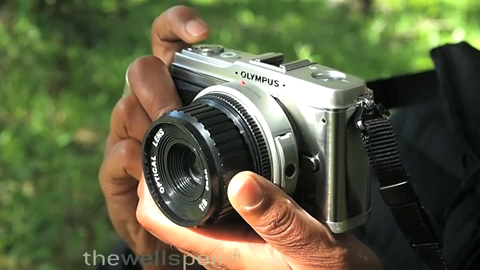A Digital Holga? (a video)
In this podcast, fine-art photographer, Annu Palakunnathu Matthew takes you along as she tests what is, in essence, a digital Holga.

The plastic lens from a toy Holga camera has been grafted onto the body cap of a digital camera. (In this case, an Olympus camera, but the same has been done for other cameras such as Nikon and Canon.) The result is the ability to photograph with the effect of a Holga lens but with the control of a digital camera body.
Great. I watched a podcast yesterday about adapting Leica M lenses to the same Olympus camera. Such wonderful tools we have at hand now! (However, one doesn’t get the same experience of taping the Olympus all over to prevent light leaks.)
Can you figure out how to make a digital Speed Graphic?
now is an expensive holga
you could use a Leica M8 and make it very expensive holga
something else i noticed in this podcast is example of how “everything old is new again.” Composing images on the LCD on an EVIL (electronic viewfinder-interchangeable lens) camera is almost like using a digital version of the “ground glass” viewfinder of a traditional 8×10 or 4×5 view camera (in which the image is composed by viewing it projected by the lens onto a sheet of frosted glass known commonly referred to as “ground glass.”) I would call it “digital ground glass” in that you’re viewing a complete version of the image on a view screen but have several digital benefits: information about exposure is displayed on the “digital ground glass:” Using the Canon EP in this podcast, Ms. Matthew was able to actually zoom in on the pre-composed image on the “digital ground glass” to precisely assess focus and areas of focus. Note, in the early days of photography cameras were view cameras. I’ll bet that Ansel Adams and Edward Weston would have loved the capability of “digital ground glass” and would have put it to good use in refining their compositions before exposing a precious film plate out in the field. Of course with the digital camera, the digital analog to film is not scarce or precious, its a flash card, which is easily swapped in the field and can be carried by the dozens.
my other takeaway is that while much of the “look” achieved with a holga or holga lens is capable of being created in photoshop, its far easer just to capture the original image with that “look” in the first place. That is probably true for a healthy % of what people do with their images in photoshop.
it doesn’t even have to be a DIY project to adapt the holga lens to a Camera. Here’s pre-made, ready to go Holga body cap lenses for Canon. The site has them for a variety of other digital cameras as well.
of course i meant olympus EP, not Canon.
No offense meant to Olympus shooters. As a Canonn user, I had Canon on the brain. At least I didn’t go so far as to say Nikon
So, just reading about some other adaptors for micro 4/3. I’ve also several great c-mount lenses for Bolex here; apparently one can also mount these. This looks like something worth experimenting with (I also see that Sony will introduce a video camera using the Micro 4/3 mount; lots of possibilities there).
Annu, could comment on the field of view produced by the holga lens? Is it similar to the Holga 120?
The lens on a Holga is about a 75mm so it projects a circular image that is a bit more than 2 inches in diameter. The Olympus (or any other digital camera with a smaller sensor) when using the Holga lens on it, only uses the center part of that projected image, so the effect is not as pronounced as with film. It is Holga-esque but not as much as with larger film.